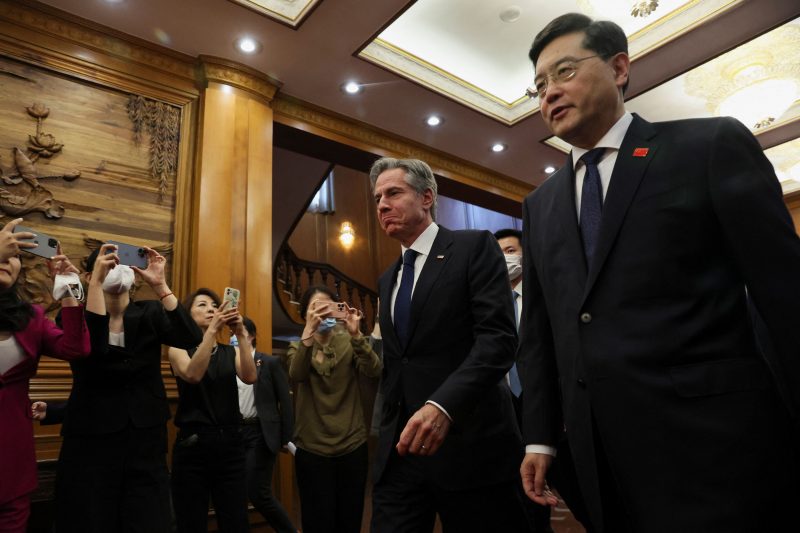When Secretary of State Antony Blinken arrived in Beijing on Sunday for two days of talks with top officials, people in China were skeptical.
The secretary’s last name when pronounced in Mandarin sounds similar to the painkiller ibuprofen. People joked on Weibo, the domestic equivalent of Twitter, that his visit would cause headaches rather than relieve them.
Instead, it appears that Blinken’s visit has acted as a remedy, at least in the short term, alleviating some of the tensions in the bilateral relationship.
“This is good for China’s international image, for its grand narrative,” said Shen Dingli, a Shanghai-based scholar of international relations.
The meeting gave Chinese leader Xi Jinping a chance to improve the country’s image abroad — not just in the United States but also in Europe, Southeast Asia and elsewhere by framing China as a reasonable partner.
“Xi is trying to address a global audience,” said John Delury, a professor of Chinese studies at Yonsei University in Seoul. “He’s almost speaking past the U.S.”
Expectations on both sides could hardly have been lower going into the trip. The secretary had called off a visit in February after a Chinese spy balloon floated across American airspace. Regular exchanges between Beijing and Washington — already at a historic low — were almost entirely frozen.
Though Blinken’s canceled trip had included a planned meeting with Xi, this time around it was left in question until the last minute.
Despite the doubt — and a decidedly more distant seating arrangement than was provided for previous secretaries of state, or even Microsoft founder Bill Gates earlier this month — Beijing billed the meeting as a success. The world needs a generally stable U.S.-China relationship, Xi told Blinken on Monday, according to state media.
Though Beijing’s tone has warmed from reproaching Blinken for unwanted meddling, the two days of what Xi called “candid and in-depth discussions” did not produce substantial agreement on core issues for Washington or Beijing. Neither side budged on military activities in the Taiwan Strait, U.S. sanctions against Chinese officials, restrictions on technology sales or the ongoing trade war.
Analysts say that instead, the meeting was a chance for Xi to continue to push his vision of China as a global power. As tensions with Washington have worsened, Xi has worked to cultivate an image of China as being at the helm of an alternative world order insulated from U.S. influence. In recent months, Beijing has issued a proposal to end hostilities in Ukraine and orchestrated a rapprochement between Saudi Arabia and Iran after years of tensions.
“This is part of Xi’s ambition to frame China as a global player and to correct a negative image of China globally — or at least to not look like the problem in the U.S.-China relationship,” Delury said. “While in Washington, the Biden administration is more focused on how to message this stuff back home than thinking that the world is watching.”
While Blinken was in Beijing on Monday, Chinese Premier Li Qiang was in Berlin, where he met with German President Frank-Walter Steinmeier as part of a trip to pursue closer economic ties with Europe and discourage the bloc from joining Washington in restricting technology exports to China.
Blinken’s trip to Beijing was also a chance for the United States and China to pick things up where they left off after Xi met with Biden on the sidelines of the Group of 20 summit in Bali last November. It was in Bali that the two sides agreed it was in their interests to cooperate rather than let the relationship deteriorate.
“In Bali, the two heads of state clearly expressed their strategic intentions,” said Wu Xinbo, the dean of the Institute of International Studies at Fudan University in Shanghai. “In Bali the focus was on mutual reassurance.”
The meeting in Bali was among a spate of diplomatic engagements by Xi that followed years of isolation during China’s harsh “zero covid” policy. Xi’s presence at the summit was a continued rollout of China’s renewed presence on the world stage that included injecting momentum into its relationship with the United States, analysts say.
The balloon threw all of that off track.
Blinken’s trip to Beijing “gets both sides where they were ready to be four months ago,” said Ford Hart, a former U.S. diplomat in China who is now a senior adviser at BowerGroupAsia. “This is where they were supposed to be before the balloon disrupted the whole thing.”
In an interview before he left Beijing on Monday, Blinken told NBC that the Biden administration considered the matter put to rest and that the balloon “chapter should be closed.”
Despite willingness to move on from the balloon incident, the lack of substantive agreement on crucial issues will remain a sticking point. Those issues include direct military-to-military communications, something Blinken said Monday that the Chinese side had rejected despite a series of dangerous recent near misses.
“From China’s perspective, Sino-U.S. military exchanges … are not for functional, crisis management or problem-solving purposes,” said Jingdong Yuan, an associate professor focused on Chinese defense policy at the University of Sydney.
Accepting guardrails for behavior in the region’s waters, as Washington has urged, would amount to accepting behavior that Beijing views as undermining its interests. “It would be difficult for China to give such an endorsement,” Yuan said.
Vic Chiang and Pei-Lin Wu in Taipei and Lillian Yang in Prague contributed to this report.



























